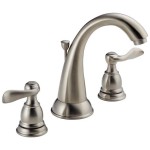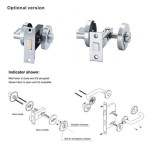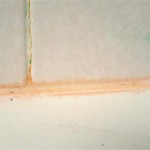Fix My Bathroom Sink: A Comprehensive Guide to Common Problems and Solutions
The bathroom sink is a crucial fixture in any home, used daily for hygiene and grooming. A malfunctioning sink can disrupt routines and create inconveniences. Understanding common problems and implementing appropriate solutions is essential for maintaining a functional and efficient bathroom. This article provides a detailed guide to diagnosing and resolving typical bathroom sink issues.
Identifying and Addressing Leaks
Leaks are among the most prevalent bathroom sink problems. They can range from minor drips to significant flows, potentially causing water damage and increasing utility bills. Pinpointing the source of the leak is the first step towards effective repair.
Faucet Leaks: These often originate from worn-out washers, O-rings, or cartridges within the faucet assembly. Over time, these components degrade due to constant use and exposure to water. Mineral buildup can also contribute to their deterioration. Identifying the specific type of faucet (compression, ball, cartridge, or ceramic disc) is crucial for selecting the correct replacement parts. Compression faucets, the oldest type, typically leak due to worn-out washers or seats. Ball faucets, characterized by a single handle that controls both temperature and flow, may leak from the spout or handle due to worn-out O-rings and springs. Cartridge faucets, easily identified by their cylindrical cartridge contained within the faucet body, often leak due to a damaged or worn-out cartridge. Ceramic disc faucets, recognized by their wide cylindrical body and single lever handle that rotates 90 degrees, are less prone to leaks but may exhibit drips due to damaged ceramic seals.
To repair a faucet leak, the water supply to the sink must be shut off. Typically, shut-off valves are located under the sink. If shut-off valves are not present or are inaccessible, the main water supply to the house must be turned off. Following the manufacturer's instructions for the specific faucet model is essential. Disassembling the faucet, inspecting the components for wear and tear, and replacing damaged parts are the core steps. When reassembling the faucet, ensuring proper alignment and tightening all connections is crucial to prevent future leaks. Applying plumber's grease to O-rings and other moving parts can extend their lifespan and improve performance.
Drain Leaks: These leaks occur at various points within the drain assembly, including the connection between the sink and the drain flange, the P-trap, and the connections to the drainpipe. The drain flange, located at the bottom of the sink basin, is responsible for directing water into the drain. The P-trap, a curved pipe under the sink, traps debris and prevents sewer gases from entering the bathroom. Leakage at the drain flange often indicates a worn-out plumber's putty or a loose connection. Leakage at the P-trap or drainpipe connections may result from loose fittings or deteriorated washers.
To repair drain leaks, the area around the leak must be cleaned and dried thoroughly. For leaks at the drain flange, removing the old plumber's putty and applying a fresh layer before tightening the flange is often effective. For leaks at the P-trap or drainpipe connections, tightening the slip nuts may be sufficient. If the washers are worn or damaged, they should be replaced. Applying Teflon tape to the threads of the drainpipe connections can help create a tighter seal.
Supply Line Leaks: These leaks occur at the connections between the shut-off valves and the faucet. Supply lines, typically flexible braided hoses or rigid copper pipes, deliver water to the faucet. Leaks often result from loose connections, corroded fittings, or damaged hoses. Inspecting the supply lines for signs of damage, such as cracks or bulges, is crucial.
To repair supply line leaks, tightening the connections with a wrench may resolve the issue. If the hoses or fittings are corroded or damaged, they should be replaced. When replacing supply lines, ensuring the new hoses are the correct length and compatible with the faucet and shut-off valves is essential. Applying Teflon tape to the threads of the connections can help prevent leaks.
Addressing Clogs and Slow Drains
Clogged drains are another common bathroom sink problem, often caused by the accumulation of hair, soap scum, and toothpaste. A slow-draining sink can indicate a partial blockage that requires attention before it becomes a complete clog.
Plunger: A plunger is a simple yet effective tool for clearing minor clogs. Creating a tight seal around the drain opening and repeatedly plunging can dislodge the blockage. Ensuring the sink contains enough water to cover the cup of the plunger is critical for creating sufficient suction.
Plumbing Snake: A plumbing snake, also known as a drain snake or auger, is a flexible tool used to break up or retrieve clogs deeper within the drainpipe. Inserting the snake into the drain opening and rotating it while pushing it forward can dislodge or pull out the blockage. Care should be taken to avoid damaging the drainpipe with the snake.
Chemical Drain Cleaners: Chemical drain cleaners are available in various formulations designed to dissolve clogs. However, these products are often harsh and can damage pipes, especially if used frequently or incorrectly. Following the manufacturer's instructions carefully and wearing protective gear, such as gloves and eye protection, is essential. Using chemical drain cleaners as a last resort after trying other methods is advisable.
Cleaning the P-Trap: The P-trap is a common location for clogs to accumulate. Disconnecting the P-trap and cleaning it out manually can effectively remove stubborn blockages. Placing a bucket under the P-trap to catch any water or debris is necessary before disconnecting it. Inspecting the P-trap for signs of damage or corrosion and replacing it if necessary is recommended.
Baking Soda and Vinegar: A mixture of baking soda and vinegar can be used as a natural alternative to chemical drain cleaners. Pouring a cup of baking soda down the drain, followed by a cup of vinegar, creates a chemical reaction that can help dissolve clogs. Allowing the mixture to sit for 30 minutes and then flushing the drain with hot water can effectively clear minor blockages.
Repairing Chips and Cracks in the Sink Basin
Chips and cracks in the sink basin can detract from the appearance of the bathroom and potentially lead to more significant damage over time. Addressing these issues promptly can help maintain the sink's integrity and prevent further deterioration.
Epoxy Repair Kits: Epoxy repair kits are designed specifically for repairing chips and cracks in porcelain, ceramic, and acrylic sinks. These kits typically include epoxy resin, hardener, and color-matching pigments. Cleaning the damaged area thoroughly and applying the epoxy mixture according to the manufacturer's instructions is essential. Sanding the repaired area smooth and polishing it to match the surrounding surface can create a seamless finish.
Porcelain Repair Kits: Porcelain repair kits are specifically formulated for repairing chips and cracks in porcelain sinks. These kits contain porcelain filler, sealant, and color-matching pigments. The damaged area must be cleaned and dried thoroughly before applying the filler. The filler should be applied in thin layers, allowing each layer to dry completely before applying the next. Sanding the repaired area smooth and polishing it to match the surrounding surface is crucial for achieving a professional-looking repair.
Acrylic Repair Kits: Acrylic repair kits are designed for repairing chips and cracks in acrylic sinks. These kits typically include acrylic resin, hardener, and color-matching pigments. The damaged area must be cleaned and roughened with sandpaper before applying the acrylic resin. The resin should be applied in thin layers, allowing each layer to cure completely before applying the next. Sanding the repaired area smooth and polishing it to match the surrounding surface is essential for achieving a seamless repair.
Professional Repair Services: For more extensive damage or if one is uncomfortable performing the repair personally, a professional sink repair service may be the best option. These services have the expertise and tools necessary to repair even significant damage to the sink basin. While professional services are more expensive than DIY repair kits, they can provide a longer-lasting and more aesthetically pleasing result.
Regular maintenance, such as promptly addressing leaks, clearing clogs, and repairing minor damage, can significantly extend the lifespan of a bathroom sink. Understanding common problems and implementing appropriate solutions is essential for maintaining a functional and efficient bathroom environment.

How To Fix A Bathroom Sink That Won T Drain Bfp Bay Area

Ceramic Porcelain Sink Repair True Value

5 Natural Ways To Unclog A Bathroom Sink Hiller How
How To Remove Scratches From A Porcelain Sink In 2024

How To Unclog A Bathroom Sink The Home Depot

6 Ways To Fix Clogged Drains Keep Pipes Flowing Freely Horizon Services

How To Fix A Leaking Bathroom Sink Paschal Air Plumbing Electric

How To Unclog A Bathroom Sink Hana S Happy Home

Best Ways To Clean Your Bathroom Sink Drain Yourself

How To Fix A Bathroom Faucet 14 Steps
Related Posts







